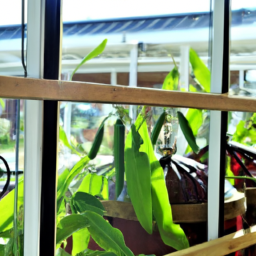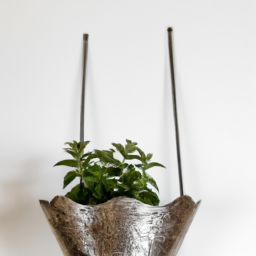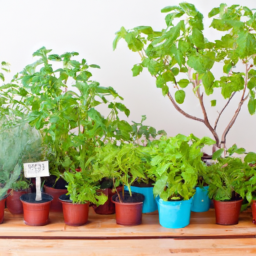
Container Gardening with Edible Plants: Growing Herbs and Vegetables Indoors
Are you a passionate foodie who dreams of having a bountiful garden, but lacks the outdoor space or a green thumb? Well, fret not! Container gardening with edible plants is here to save the day. Whether you live in a tiny apartment or a house with limited yard space, you can still enjoy the pleasure of growing your own fresh herbs and vegetables indoors. In this blog post, we will explore the wonderful world of container gardening and discover how you can cultivate a thriving edible garden right in the comfort of your own home. So, grab your gardening gloves and let’s dive into the exciting realm of growing herbs and vegetables indoors!
Benefits of Container Gardening with Edible Plants
Container gardening with edible plants is a wonderful way to bring the joy of gardening into small spaces, such as apartments or houses with limited outdoor areas. Not only does it allow you to grow your own herbs and vegetables, but it also offers numerous benefits that make it an attractive option for both experienced gardeners and beginners alike.
1. Flexibility and Convenience
One of the greatest advantages of container gardening is its flexibility. Unlike traditional gardening, which requires a dedicated plot of land, container gardening allows you to grow plants in various containers such as pots, buckets, or even recycled materials like old tires or plastic bottles. This means you can place your plants wherever you like, whether it’s a sunny windowsill, a balcony, or a small patio.
Additionally, container gardening offers convenience. As the plants are grown indoors, you have easy access to fresh herbs and vegetables right in your kitchen. No need to venture out to the garden or worry about weather conditions. This convenience is particularly beneficial for those with physical limitations or busy schedules, as maintenance tasks like weeding and watering are reduced.
Furthermore, container gardening allows you to experiment with different plant varieties and arrangements. You can easily move the containers around to optimize sunlight exposure or create aesthetically pleasing displays. This flexibility and convenience make container gardening a practical and enjoyable option for anyone interested in growing their own edible plants.
2. Maximizing Space and Yield
Another advantage of container gardening is its ability to maximize space and yield. With limited outdoor areas, it can be challenging to grow a variety of plants. However, by utilizing containers, you can make the most of your available space and grow a wide range of herbs and vegetables.
When it comes to maximizing yield, container gardening allows you to control the growing conditions more effectively. You can choose the appropriate soil mix, provide optimal drainage, and ensure adequate sunlight exposure for each plant. This level of control helps plants thrive and increases their productivity. Additionally, container gardening minimizes the risk of pests and diseases, as the plants are isolated from the ground and other potential sources of contamination.
Moreover, container gardening enables you to extend the growing season. Indoor environments provide a more stable and controlled climate, allowing you to grow plants year-round. By selecting suitable plant varieties and providing the necessary conditions, you can enjoy a continuous supply of fresh herbs and vegetables regardless of the external weather.
3. Enhancing Aesthetics and Well-being
Container gardening not only offers practical benefits but also enhances the aesthetics of your living space. Indoor plants add a touch of greenery and natural beauty to any room, creating a pleasant and calming atmosphere. The vibrant colors and textures of herbs and vegetables can be visually appealing and contribute to a visually pleasing indoor environment.
Furthermore, studies have shown that indoor plants have a positive impact on our well-being. They can improve air quality by reducing pollutants and increasing oxygen levels. Additionally, caring for plants has been found to reduce stress levels and promote a sense of relaxation and well-being. Container gardening provides an opportunity to connect with nature and experience the joy of nurturing living organisms, which can be incredibly rewarding for both mental and emotional health.
In conclusion, container gardening with edible plants offers numerous benefits, including flexibility, convenience, space optimization, increased yield, and aesthetic enhancement. It provides an accessible and enjoyable way to grow your own herbs and vegetables indoors, regardless of your living situation or gardening experience. So why not embark on the journey of container gardening and experience the joy of harvesting your own fresh produce right from your home?
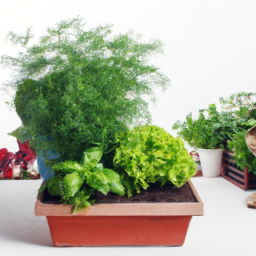
Essential Tips for Growing Herbs and Vegetables Indoors
Growing herbs and vegetables indoors can be a rewarding and convenient way to have fresh produce at your fingertips all year round. Whether you have limited outdoor space, live in an apartment, or simply want to enjoy the benefits of gardening indoors, container gardening is the perfect solution. In this guide, we will provide you with essential tips to successfully grow herbs and vegetables indoors, ensuring a bountiful harvest and a beautiful indoor garden.
Choosing the Right Containers
When it comes to container gardening, selecting the right containers is crucial for the health and growth of your plants. Here are some key factors to consider:
1. Size: Choose containers that are appropriate for the size of the plants you wish to grow. Some herbs and vegetables require deeper pots, while others can thrive in shallow containers. Ensure that the containers have adequate drainage holes to prevent waterlogging.
2. Material: Opt for containers made of lightweight materials such as plastic or fiberglass, as they are easier to move and handle. However, if you prefer a more natural look, you can also use terracotta or ceramic pots. Just make sure they are properly sealed to prevent water leakage.
3. Quantity: Consider the number of plants you want to grow and the available space in your home. You can either choose individual containers for each plant or use larger containers to accommodate multiple plants. Just ensure that there is enough space for each plant to grow and receive adequate sunlight.
Providing Adequate Light
Light is one of the most important factors for successful indoor gardening. Most herbs and vegetables require at least 6-8 hours of direct sunlight per day. Here are some tips to ensure your plants receive adequate light:
1. Location: Find a sunny spot in your home near a window where your plants can receive maximum sunlight. South-facing windows are ideal, as they provide the most sunlight throughout the day. If your home lacks natural light, consider using artificial grow lights specifically designed for indoor gardening.
2. Rotate: Rotate your plants every few days to ensure even exposure to light. This will prevent them from leaning towards the light source and promote balanced growth.
3. Reflective Surfaces: Place reflective surfaces, such as aluminum foil or mirrors, near your plants to maximize the amount of light they receive. This can help redirect sunlight to areas that may be shaded.
Watering and Fertilizing
Proper watering and fertilizing are essential for the health and productivity of your indoor garden. Here are some guidelines to follow:
1. Watering: Check the moisture level of the soil regularly and water your plants when the top inch of soil feels dry. Avoid overwatering, as it can lead to root rot. Ensure that the containers have proper drainage to prevent water accumulation.
2. Fertilizing: Use a balanced, water-soluble fertilizer formulated for edible plants. Follow the instructions on the package to determine the appropriate frequency and dosage. Over-fertilizing can harm your plants, so it’s important to use fertilizer sparingly.
3. Nutrient-rich Soil: Use high-quality potting soil that is well-draining and rich in nutrients. Avoid using garden soil, as it may contain pests or diseases that can harm your indoor plants.
Harvesting and Pruning
Regular harvesting and pruning are necessary to promote healthy growth and prolong the productivity of your herbs and vegetables. Here’s what you need to know:
1. Harvesting: Harvest your herbs and vegetables when they reach the desired size. Regular harvesting encourages new growth and prevents plants from becoming leggy or overcrowded. Use sharp scissors or pruning shears to avoid damaging the plants.
2. Pruning: Prune your plants regularly to remove dead or yellowing leaves, as well as any overcrowded or damaged branches. This will improve air circulation and reduce the risk of diseases.
3. Replanting: Some herbs and vegetables may need to be replanted after a certain period to maintain their productivity. Check the specific requirements of each plant and replant as needed.
By following these essential tips, you can create a thriving indoor garden filled with delicious herbs and vegetables. Enjoy the satisfaction of growing your own food while adding beauty and freshness to your home. Happy gardening!
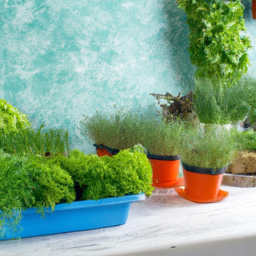
Best Edible Plants for Container Gardening
Container gardening is a wonderful way to bring the joy of growing your own food indoors. Whether you have limited outdoor space or simply want to enjoy fresh herbs and vegetables year-round, growing edible plants in containers is a practical and rewarding option. In this article, we will explore the best edible plants for container gardening and provide you with a step-by-step guide to get started.
1. Herbs
Herbs are excellent choices for container gardening due to their compact size and versatility. They not only add flavor to your dishes but also provide aromatic scents and attractive foliage. Here are some popular herbs that thrive in containers:
Basil: This aromatic herb is a staple in many kitchens. It loves warm temperatures and requires at least six hours of sunlight per day. Plant basil in a well-draining potting mix and water it regularly to keep the soil moist.
Mint: Mint is a refreshing herb that is easy to grow in containers. It prefers partial shade but can tolerate some sunlight. Keep the soil consistently moist, and be cautious as mint can be invasive. Plant it in a separate container to prevent it from taking over other plants.
Parsley: Parsley is a versatile herb that adds a fresh taste to various dishes. It thrives in partial shade and requires well-draining soil. Water parsley regularly and provide it with enough space to grow, as it can become quite bushy.
2. Leafy Greens
Leafy greens are packed with nutrients and are perfect for container gardening. They grow quickly and can be harvested multiple times. Here are some popular leafy greens to consider:
Spinach: Spinach is a nutritious green that thrives in containers. It prefers cooler temperatures and partial shade. Keep the soil consistently moist and harvest the outer leaves regularly to encourage new growth.
Lettuce: Lettuce is an easy-to-grow green that comes in various varieties. It prefers cooler temperatures and partial shade. Plant lettuce seeds or seedlings in well-draining soil and water it regularly to keep the soil moist. Harvest the outer leaves when they reach a desirable size.
Kale: Kale is a nutrient-dense green that is becoming increasingly popular. It thrives in cooler temperatures and can tolerate some shade. Plant kale in a large container and provide it with well-draining soil. Water it regularly and harvest the outer leaves as needed.
3. Compact Vegetables
Many vegetables can be successfully grown in containers, even if you have limited space. Here are some compact vegetables that are well-suited for container gardening:
Cherry Tomatoes: Cherry tomatoes are perfect for container gardening, as they produce an abundance of small fruits. Choose a dwarf or determinate variety that doesn’t require staking. Plant them in a large container with well-draining soil and provide support for the vines if needed.
Radishes: Radishes are quick-growing vegetables that are ideal for container gardening. They prefer cooler temperatures and well-draining soil. Sow radish seeds directly into the container and thin them out as they grow. Harvest radishes when they reach a desirable size.
Peppers: Peppers come in various sizes and heat levels, making them a versatile choice for container gardening. Choose a compact or dwarf variety that suits your taste. Plant peppers in a large container with well-draining soil and provide support for the plants if needed. Water them regularly and provide sufficient sunlight.
Container gardening with edible plants allows you to enjoy the taste of fresh herbs and vegetables right from your own home. By selecting the right plants and providing them with the optimal growing conditions, you can create a thriving indoor garden. Remember to regularly monitor your plants for pests or diseases, and adjust watering and sunlight accordingly. Happy container gardening!
Highlights of this article
Container gardening is a fantastic way to grow your own herbs and vegetables, even if you don’t have a backyard or a large outdoor space. With the right containers and a little bit of care, you can create a thriving indoor garden that will provide you with fresh and flavorful ingredients all year round. Whether you have a small apartment or simply want to have easy access to your favorite herbs in the kitchen, container gardening is a convenient and rewarding option.
To get started, choose the right containers for your plants. Opt for pots with good drainage and enough space for the roots to grow. You can use traditional clay pots or get creative with repurposed containers like mason jars or even old tin cans. Next, choose the herbs and vegetables you want to grow. Popular choices for indoor gardening include basil, mint, parsley, cherry tomatoes, and lettuce. Remember to consider the sunlight requirements of each plant and place them near a window that receives enough light. Finally, provide your plants with the right amount of water and fertilizer. Be mindful not to overwater, as this can lead to root rot. Regularly check the moisture levels in the soil and adjust your watering schedule accordingly. With patience and care, you’ll soon be enjoying the fruits of your labor in the form of fresh and delicious homegrown ingredients.
Q&A Corner:
Q1: What is container gardening with edible plants?
A1: Container gardening with edible plants refers to the practice of growing herbs and vegetables indoors using containers such as pots, planters, or even recycled items like buckets or old jars. It allows you to cultivate a variety of edible plants in limited spaces, making it ideal for those who have small yards, balconies, or no outdoor garden at all.
Q2: What are the benefits of container gardening with edible plants?
A2: Container gardening with edible plants offers several advantages. Firstly, it allows you to have fresh herbs and vegetables right at your fingertips, ensuring their quality and reducing the need for store-bought produce. It also enables you to control the growing conditions, such as sunlight, water, and soil quality, resulting in healthier plants. Additionally, container gardening is a convenient way to enjoy gardening and nature, even in urban areas.
Q3: Which herbs and vegetables are suitable for container gardening indoors?
A3: Numerous herbs and vegetables thrive in containers indoors. Some popular choices for herbs include basil, parsley, cilantro, thyme, and mint. As for vegetables, options like cherry tomatoes, lettuce, spinach, radishes, and peppers can be successfully grown indoors. It’s essential to choose compact varieties specifically bred for container gardening, as they require less space and have better adaptability to indoor conditions.
Q4: What are the key considerations for successful container gardening indoors?
A4: To ensure successful container gardening indoors, there are a few key considerations to keep in mind. First, choose containers with proper drainage holes to prevent waterlogging. Use well-draining potting soil designed for container gardening. Place your containers in an area that receives adequate sunlight, typically near a south-facing window. Regularly water your plants, but avoid overwatering. Finally, consider supplementing with artificial lighting, especially during winter months with limited natural light.
Q5: How do I care for edible plants grown indoors in containers?
A5: Caring for edible plants grown indoors in containers involves a few essential steps. Regularly monitor the moisture level of the soil and water your plants when the top inch feels dry to the touch. Fertilize your plants with a balanced organic fertilizer according to the package instructions. Keep an eye out for pests and diseases, and promptly address any issues that arise. Prune your plants as needed to encourage healthy growth and prevent overcrowding. Lastly, rotate your containers periodically to ensure all sides of the plants receive adequate light.
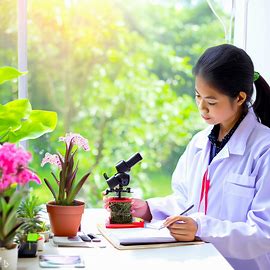
Lisa Chen is a seasoned indoor gardening expert and the author of several bestselling books on the topic. With a background in horticulture and urban farming, Lisa is dedicated to helping urban dwellers embrace the joys of cultivating green spaces indoors. Her detailed guides and hands-on tips empower readers to transform their living spaces into thriving plant sanctuaries.

